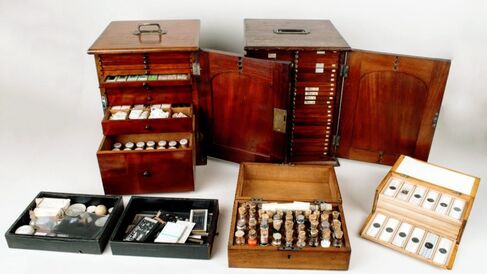The Foraminifera Slides and Working Tools of Microscope Slide Maker Charles Elcock

Charles Elcock (1834-1910) was a naturalist, museum curator, and professional microscope slide maker who spent his working life in Belfast. In September 2015 the Whipple Museum acquired his remarkable personal archive of slides and mounting materials (above). Studied together, these objects, books, and tools provide a rare insight into the often overlooked world of nineteenth century microscope slide manufacture.
From hobbyist to professional
Although Elcock was born into a Quaker family in Pontefract, Yorkshire, he spent the majority of his working life in Belfast, Ireland, settling there shortly after marrying a resident of the area, Harriett Sophia Green, in 1876. Initially employed as a clerk, records from the era suggest that Elcock was a keen naturalist in his spare time, with a particular interest in making his own microscope slides. In 1879 prize judges for the Belfast Naturalists’ Field Club wrote of Elcock’s work:
“The mounted objects are chiefly of Foraminifera, illustrated by a great variety of species, and several excellent methods of mounting. All are prepared with artistic skill and superior finish. We recommend that the prize be awarded to Mr. Elcock.” (1)
Foraminifera are minute single-celled aquatic microorganisms that form protective shells. They date back to at least the early Cambrian period, 540 million years ago, and fossils of their shells are prevalent in a wide variety of geological settings. Elcock collected these tiny fossils, both personally and through the post from friends and colleagues, skillfully mounting them in intricate arrangements according to their various types (Image 1).
By 1880 Elcock’s work had attracted enough attention that he began selling his slide preparations through agents in London, Manchester, and Bath. Each large rectangular ‘Type Slide’ cost twenty shillings and contained fifty different species mounted next to their scientific name, printed in microscopic text next to each specimen.
'Microscopist': Scientist or craftsman?
The materials preserved in this personal archive offer an important window onto the life and working practices of Elcock. These materials were in Elcock's possession at the time of his death, and we can therefore presume that they represent slides and tools that remained significant to him.
Because Elcock only published research papers sporadically and in obscure journals, his career would likely have been forgotten were it not for the survival of these material objects. Together, they point to an intriguing commercial scientific career. After his initial start as an amateur Elcock appears to have made a living from his slide preparations, and by 1901 he was listing his profession as 'microscopist' whilst also serving as the Curator of the Art Gallery and Museum at the Free Public Library in Belfast.
His output diversified, and his surviving collection preserves examples of dozens of different types of foraminifera slide produced by him for sale. Specimens provided to him from major expeditions are present, including from the important Challenger, Porcupine, and Knight Errant scientific surveys, preserved here alongside numerous specimens from Irish locations. Together they form a unique record of global foraminifera study at the turn of the twentieth century (Image 2). Other types of slide are also included, such as stained histological tissue sections, four of which retain handwriting that indicates they were made for at least one Belfast doctor.
Preserved alongside the slides in neatly fitted cabinets and drawers are the tools of Elcock's trade (Image 3). Powdered stains, mounting materials, and a cornucopia of mountable substances survive, ranging from "Decomposed glass found at Roman ruins in Gloucester" to an Emu's feather. Paper materials attest to Elcock's diverse skills and interests, such as a set of beautiful watercolour sketches of moss spores, as studied under the microscope. And Elcock's personal life can also be glimpsed, for example through the survival of his personal homeopathic apothecary cabinet.
Together the collection encapsulates the work of a mostly forgotten profession. As a 'microscopist', Elcock was both a man of science and a craftsperson, his work spanning the realms of academic research, commercial scientific manufacture, and public education.
- Quoted in: B. Stevenson, 'Charles Elcock, 1834-1910', microscopist.net online article, 2014.
Joshua Nall
Joshua Nall, 'The foraminifera slides and working tools of microscope slide maker Charles Elcock', Explore Whipple Collections, Whipple Museum of the History of Science, University of Cambridge, 2015.
